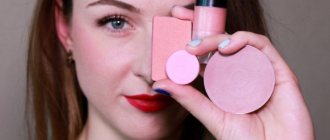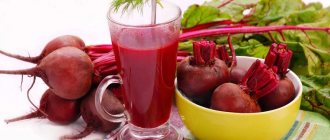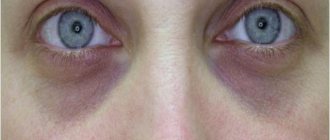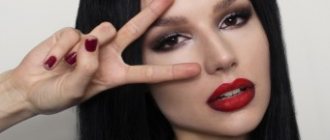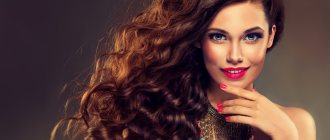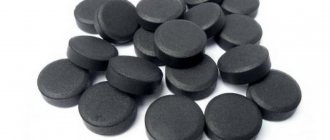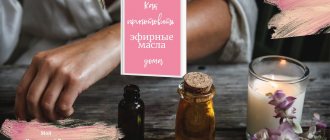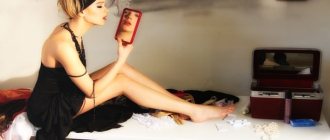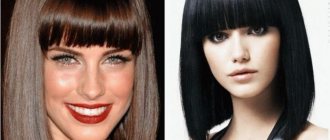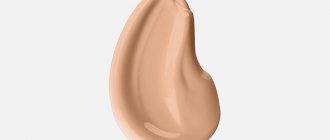Modern canons of beauty require that a woman’s face be well-groomed, with a light, healthy blush on her cheeks. The elastic pink cheeks of young girls (thanks to good blood circulation in the subcutaneous capillaries) are bright in themselves and do not require additional tinting. But what if blood flow worsens over the years, the consequences of ailments and long-term smoking take their toll, and a woman’s skin becomes dull and lifeless?
This is where blush comes to the rescue. They are assigned two important tasks when performing makeup:
- Blush gives the face naturalness and freshness. Even if you skillfully gave an even tone to your face using foundation, without a slight blush it will still resemble a lifeless mask. A drop of blush can restore the vibrancy of natural colors to the face. The use of blush is especially important in the cold season, when the skin becomes pale, with an unhealthy bluish tint.
- Blush makes it possible to correct the shape of the face, visually masking its imperfections.
What should you consider when choosing?
Modern industry produces two types of blush:
- Dry (powdery).
- Liquids, which include blush:
- mousses;
- gel;
- creamy.
The liquid form of blush is more suitable for those with dry skin and older women, as they have a refreshing and rejuvenating effect. Younger women with other skin types will find both types of blush equally suitable.
All types of blush have a special characteristic (the so-called “finish”) - this is the effect that remains on the face after application. The finish happens:
- matte;
- satin;
- brilliant.
Shiny blush can be used to create evening makeup. During the day they will look quite ridiculous. Daytime makeup is best done using matte or satin blush.
How to apply blush on your face?
- The first myth is that you should not apply blush closer than two fingers from your nose. But you need to take into account the thickness of your fingers and the width of your face so that the blush does not end up somewhere on the sides of your face.
- The second myth prohibits applying blush lower than the tip of the nose. But the owner of a charming snub nose who follows this rule will have a higher blush than necessary.
- The third myth: applying blush according to your face type. To correct the shape of the face, foundation and powder of different shades are used, and blush is just a way to add life, color, and youth to your face.
- The last myth instructs mature ladies to use products of more intense color than young ladies. But as your skin ages, your cheekbones don’t go away, and at any age you can highlight them with the color that suits you.
Choice by skin color and appearance color type
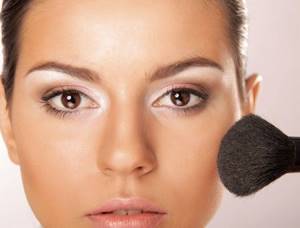
How to choose blush depending on your color type? It is best to focus on a combination of hair color and skin tone.
- Blushes in bronze, peach and beige-brown shades are most suitable for brunettes with dark skin. Blush of orange and hot pink colors is completely contraindicated for them, since they will only unfavorably highlight the darkness of the skin. For women with a winter color type (with cool undertones and very fair skin), pinkish-beige blush is most suitable. They should be careful when choosing too bright cosmetics in warm colors: with this type of appearance it will look too vulgar.
- For blondes with a spring color type (with hair and skin of warm tones), blush in peach or apricot tones is ideal. All shades of coral and terracotta will also be appropriate. Blondes of the summer color type (with cool tones of hair and skin) should opt for all shades of pink and pink-beige. Brick and warm red shades are unacceptable for this type.
- Brown-haired women with chestnut-colored hair or dark blond curls with a golden tint will be irresistible by choosing a pinkish-brown shade of blush. For ashy hair and cool skin tones, you should opt for pink or beige-pink blush.
- For girls of the autumn color type with red hair, brown-pink, peach, beige, terracotta and brick tones are suitable.
Choosing based on eye color
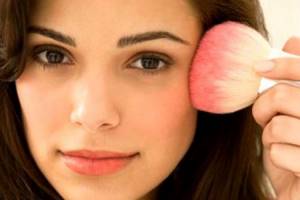
When asking yourself the question of how to choose the color of blush, also consider the shade of your eyes.
- Blush of a cold pink shade (for cold and light skin tones) and light peach (for warm skin tones) can highlight and enhance the brightness of blue eyes.
- Pink shades of blush are good for girls with green eyes.
- The beauty of brown eyes will be highlighted by blush shades of ripe berries. For hazel eyes, a mauve blush will suit you.
Correcting your face shape with blush
To learn how to properly apply blush on your face, you should consider its shape.
- To give relief to a wide, flat face, apply light strokes of not too dark blush along the hairline, along the temples and along the outer contours of the cheeks (up to the chin).
- When correcting a heart-shaped face, blush applied to the cheeks and shaded towards the ears and highlighting the cheekbones.
- When applying blush to an oval face, you can visually shorten it by making horizontal strokes on the cheekbones.
- To correct a wide face, blush is applied to the cheekbones and shaded upward, towards the hairline (and in no case on the cheeks).
- You can make a round face look longer by applying blush in a triangle (from the temples to the corners of the mouth).
- To visually smooth out the corners of a square face, you need to apply blush to the middle of the cheeks.
- To widen a too narrow face, blush is applied from the cheekbones to the middle of the ear, using horizontal strokes.
- If your face is pear-shaped and you need to hide the massiveness of your chin, you need to apply a wide strip of blush from the middle of your cheeks to the middle of your ear.
- A chin that is too short can be lengthened by highlighting the dimple in it with a light-colored blush.
- A long nose will appear visually shorter if you rub a drop of dark blush in the hollow underneath it.
- If your chin is too sharp, you can round it out using dark shades of blush.
The best brands of the season
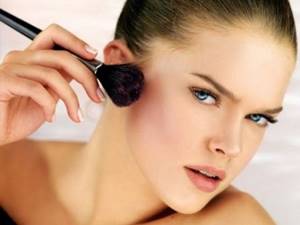
Signs of good quality blush are the following:
- lie evenly on the skin (or foundation makeup);
- easy to shade;
- not subject to smearing and shedding;
- stays on the face for a long time;
- include facial care components;
- suitable for facial correction.
The best brands of the season have all these qualities:
- powder blush Touche Blush (from Yves Saint Laurent);
- Dream mousse blush (from Maybelline);
- cream blush from the Lanita Flora series (from Rouge Bunny Rouge).
The Middle Ages - a time without blush
In the Middle Ages, rosy cheeks were out of the question in the upper echelons of society. Firstly, pale skin in the Middle Ages was proclaimed one of the main advantages of aristocrats. People of noble birth do not work like peasants all day in the fields and, accordingly, do not sunbathe. A tan in those days was considered a sign of a person from the lower strata of society. Aristocrats were distinguished by porcelain skin. This idea of tanning would exist in Europe until the beginning of the twentieth century.
Secondly, all cosmetics were banned in the Middle Ages. Since the clergy believed that painting one’s face was deception. And lying is one of the deadly sins.
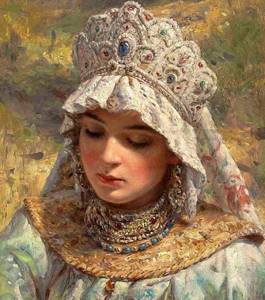
Artist K. Makovsky Young Lady
In the Middle Ages, rosy cheeks were valued only among peasants. Among the peasants, natural blush was considered a sign of health. Peasant women could also use beets to make their cheeks even brighter.
Beetroot was also used as blush in Muscovite Rus'. In Muscovite Rus', not only peasant women, but also noblewomen blushed their cheeks. At the same time, the blush should have been as bright as the cheeks of a nesting doll.

Artist Francois Boucher Marquise de Pompadour
In the 16th-18th centuries in Europe, pale faces were still fashionable among aristocrats. To make their faces white, they begin to cover them with a thick layer of white. And to emphasize such artificial pallor, lips are painted with bright red lipstick, and cheeks are painted with blush. The paint is the same as in Antiquity - ocher, cochineal, poisonous vermilion.
XVIII century – the time of dominance of hot pink blush
The popularity of blush reached a particular peak during the Rococo period - the 18th century. The 18th century can well be called the century of rouge. In honor of the trendsetter at the French court during the time of King Louis XV, the Marquise de Pompadour even named one of the shades of pink - “Pink Pompadour”.
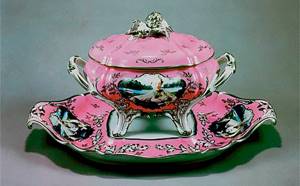
Porcelain color “Pink Pompadour” This is the color the Marquise de Pompadour wore blush
And the French Queen Marie Antoinette performed a whole ritual of applying blush every morning.
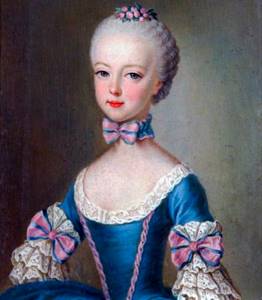
Marie Antoinette
Morning ritual of the French queen Marie Antoinette:
1.
Non-public part - washing the face and body, applying whitewash to the face and styling hair
2.
Public part - in the presence of the courtiers, the queen applied blush. At the same time, following etiquette, the queen could not take jars and puffs herself. Jars and puffs one after another for some time were served to the queen by the ladies of the court serving her, and she herself only applied blush to her cheeks.
Marie Antoinette applied blush in circles of bright scarlet color.
In the 17th-18th centuries, blush, like whitewash, was used not only by women, but also by men.
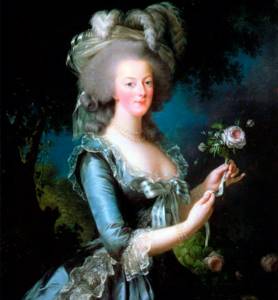
Marie Antoinette
In the 19th century, under the influence of strict English fashion, blush was practically not used in high society. Only actresses and singers paint their cheeks. And girls from noble families can only pinch their cheeks and bite their lips to give them brightness.
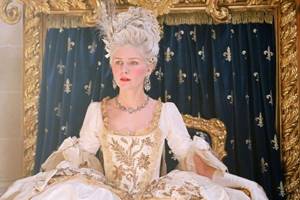
Still from the film “Marie Antoinette”
But at the same time, in the 19th century, blush was already produced in many versions - blush in the form of liquid tinctures, wax-like lipsticks, blush in the form of powder. Bottles, jars, books with blotter pages (paper strip tester) and even scraps of fabric served as packaging for blush.

1920s makeup
In the 1920s, blush, like lipstick, became a must-have item in the makeup bags of girls from all walks of life. But the fashion for blush does not last long.
XX century – tan versus blush
In the same 1920s, the fashion for tanning appeared. Now tanning is not associated with low origin. Tanning, on the contrary, becomes a sign of women from high society. And blush remained in the background compared to other cosmetics throughout almost the entire twentieth century.

Madonna 1980s Makeup
The blush fashion only reappeared in the makeup of the 1970s and 1980s. At this time, blush was applied in wide and bright stripes, practically without shading, on the cheeks and cheekbones.
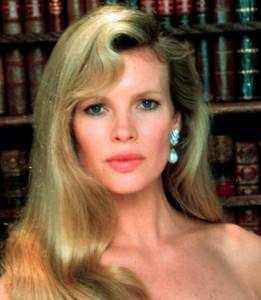
Kim Basinger - actress and model
The fashion for blush continued into the 1990s. Today, in makeup, blush is used to give the face freshness and youth.
Application secrets from experienced practitioners!
- How to use blush to make your face look a little longer? To do this, they need to be applied closer to the hairline. There is a simple trick: sucking in your cheeks, apply a blush of a darker shade to the resulting depression, as if depicting the letter “c”. The drawn line should not rise above eye level.
- To achieve a natural effect, blush should be applied where your own blush usually appears. You just need to blend the blush very carefully.
- To make it more attractive, a small amount of blush with a shimmering effect can be applied to the very top of the cheekbones (near the eyes).
- Avoid applying blush to the area under the cheekbones to avoid aging your face.
- Applying blush close to your nose can also make your face look older, so it's best not to do this.
- To refresh your complexion, you can apply a small amount of blush in the most delicate shades to the end of the chin, temples and along the hairline.
- The effect of a fresh face can be achieved by applying matte dry blush along the hairline (from the right ear to the left) and then blending it towards the face.
- Mature women should give preference to gel or cream-based blush, as they refresh the face and disguise wrinkles. To do this, apply a small amount of rich blush to the apples of the cheekbones with your fingertips and carefully blend, imitating a natural blush.
What kind of brush should you use to apply blush?
Most often, women opt for compact powder blushes. They are the easiest to apply and can be mixed to achieve the perfect shade that will highlight your skin tone and make it sparkle. For this, it is important to choose a brush with which the blush will be applied well and go on easily.
- In order not to overdo it with blush, use fluffy, soft, voluminous brushes: thanks to this structure, the layer of blush will always be thin and even.
- An ideal brush for blending blush - with a dual composition - made of natural and synthetic bristles: it is suitable for both loose product and will help to distribute cream blush well.
- If you want to achieve a specific visual effect, use a slightly angled brush. It will help you apply blush more precisely and accentuated, and will also make it easier to work with highlighter and bronzer if you use them in your makeup.
The best options for universal blush brushes that will last you more than one year:
- Diffusing Blush Brush from Urban Decay,
- Giorgio Armani - Maestro Blush Brush,
- MAC – 187, MAC – 168,
- Sigma – F50, Sigma – F40,
- Laura Mercier – Finishing brush,
- Sephora – Stippling brush,
- Guerlain – Angled Blush brush.
